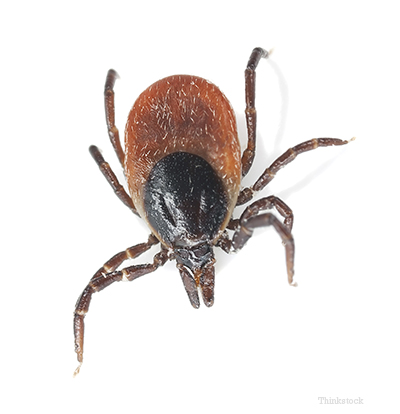
When you think of summer dangers, you might think of things like heat stroke and poisonings. While these are very real threats, don’t let yourself forget about the dangers that ticks pose your dogs — risks like Lyme disease. Click here for Lyme disease basics or read on for advanced tips about how to avoid this nasty condition.
Lyme disease, caused by a spiral-shaped organism called Borrelia burgdorferi (Bb), can affect humans, dogs, horses, and other species. Depending on what state you live in, Lyme disease can pose a greater or smaller health danger to your dog this summer. Click here to view a map and see if your state is at risk.
Click here to view a map and see if your state is at risk.
It’s worth noting that of all the dogs who test positive for Lyme disease in high prevalence states, only 5% of these dogs ever go on to develop infection or show clinical signs.1-3
Transmission of Lyme disease (Bp)
It’s important to understand the transmission of Lyme so that we know how to prevent its spread. While Lyme can be transmitted by urine, milk, and blood, the most common transmission is likely via tick infestation by hard-shell deer ticks (e.g., Ixodes scapularis or other related Ixodes species). Ixodes ticks have a 2-year life cycle1,2 and hatch in the spring (into larvae). A female tick lays approximately 2000 eggs.1 Larvae become infected with Lyme when feeding on white-footed mice. The tick larvae molt into nymphs that feed on new hosts. Likewise, nymphs can become infected when feeding on an infected animal. In the fall, nymphs molt to adults, with 50% of adult ticks in the Northeast estimated to be carrying Lyme.4 Once the tick attaches and feeds, Lyme(which lives in the midgut of the tick) begins to migrate to the salivary gland and enter the host (typically the dog).
Risk of infection is believed to be minimal during the first 12 hours of feeding;4 rather, Lyme disease typically takes prolonged feeding periods to be transmitted to your dog or you.1,4 For this reason, it’s important to use a flea and tick medication that kills insects quickly (ideally in less than 12-24 hours), as it almost guarantees that Lyme can’t be transmitted to your dog!
What if my dog is already positive for Lyme disease?
If your dog tests positive for Lyme disease, it doesn't always require long-term antibiotic therapy. If your veterinarian does prescribe therapy, it would likely be a drug called doxycycline (typically for 4-6 weeks). Make sure you ask your veterinarian these key questions:
- Is this area a Lyme endemic area?
- What can I do to prevent further exposure?
- Does my dog have clinical signs?
- Does my dog have a presence of protein in the urine?
If the answer to either of the last two questions is yes, talk with your veterinarian about treatment.
Protecting your dog from summer ticks
If your dog did test positive for Lyme disease (commonly tested for using an IDEXX SNAP 4Dx® Plus Test), it means your dog has been exposed to Bb (Lyme). While this may not necessitate treatment, it does mean that you need to improve your prevention methods!
Here are the best ways to prevent Lyme disease:
- Use a flea and tick medication that kills quickly (ideally in less than 12-24 hours, to prevent the transmission of Bb to your dog). Just last month, Merck Animal Health released a unique, fast-acting oral medication called Bravecto. Not only does it kill fleas and ticks in < 12 hours, but it’s an oral, long-lasting medication that works for 12 weeksI).
- Use a flea and tick comb to brush through your dog from head to tail (focusing on the armpits, behind the ears, and the underbelly) after you go hiking in the woods; the sooner you pull off a tick, the better!
- Talk to your veterinarian about the Lyme vaccine if you are in an endemic area or if you have a breed at risk for developing severe complications from Lyme disease (e.g., Golden retrievers, Labrador retrievers, Shetland sheepdogs)
- Consider changing the landscaping in your backyard to minimize ticks. Better yet, if you want fresh eggs and less ticks, consider backyard chickens (if your city allows them) as they love to eat ticks!
Prognosis of Lyme disease in dogs
Ultimately, the decision to treat a dog testing positive for Lyme disease should be based on clinical signs, breeds at risk, owner concerns, and evidence of protein in the urine. The prognosis for acute Lyme disease is excellent, and most dogs respond within 2-3 days of antibiotic therapy. Even recurrent clinical signs appear to respond to additional courses of antibiotic therapy (as compared to response in humans with recurrence).
Some dogs may also spontaneously recover from Lyme disease without therapy at all. That said, the prognosis for chronic manifestations of Lyme disease (e.g., Lyme nephritis) is grave. Again, preventive care is imperative to help minimize the incidence of clinically symptomatic Lyme infection. The best thing you can do is use aggressive prevention!
I. Because of the way they feed, Bravecto only protects against the lone star tick for 8 weeks.
If you have any questions or concerns, you should always visit or call your veterinarian -- they are your best resource to ensure the health and well-being of your pets.
The opinions and views expressed in this post are those of the author's and do not necessarily represent the beliefs, policies or positions of PetHealthNetwork.com, IDEXX Laboratories, Inc. or its affiliates and partner companies.
Sources:
- Appel JMG. Lyme Disease. In Blackwell’s Five-Minute Veterinary Consult: Canine & Feline. Eds. Tilley LP, Smith FWK. 2007, 4th ed. Blackwell Publishing, Ames, Iowa. pp. 784-785.
- Littman MP, Goldstein RE, Labato MA, et al. ACVIM Small Animal Consensus Statement on Lyme Disease in Dogs: Diagnosis, Treatment and Prevention. J Vet Int Med 2006;20:422-434.
- Appel JMG. Lyme disease vaccination. In Kirk’s Current Veterinary Therapy XIII. Ed. Bonagura JD. 2000. W.B. Saunders, Philadelphia, PA. pp. 256-258.
- An overview of Lyme disease in dogs, Baker Institute, Cornell University, Accessed May 5, 2014 at http://bakerinstitute.vet.cornell.edu/animalhealth/page.php?id=1101
